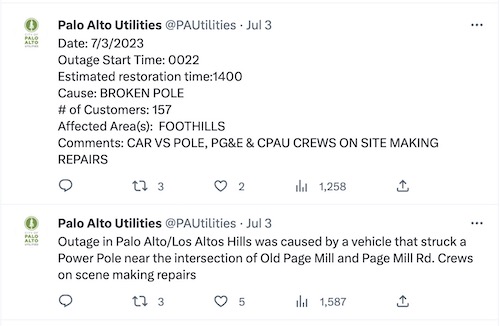How reliable is our electricity? On average it’s not bad but in many places it’s getting worse and in a few places it’s downright terrible. Customers in PG&E territory are seeing more power outages and more outage-minutes, particularly in areas where the utility de-energizes circuits in order to prevent accidental ignitions that can lead to wildfires.
The chart below shows how many outages an average PG&E customer experienced each year. In 2022 there was less than one outage per customer per year on average. (1) That is not bad, but it is almost a 50% increase over 2021, and the average hides a very uneven distribution.
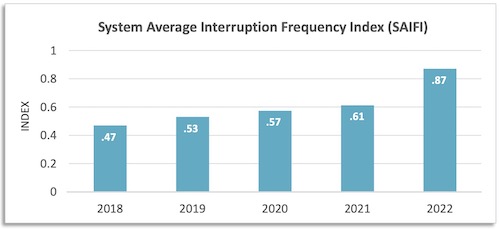
This chart shows the average number of outages per PG&E customer per year, which has been increasing. Source: CPUC Reliability Workshop, PG&E Presentation (2023)
The average outage-minutes a PG&E customer sees each year has also been steadily increasing, up almost 250% in just five years.
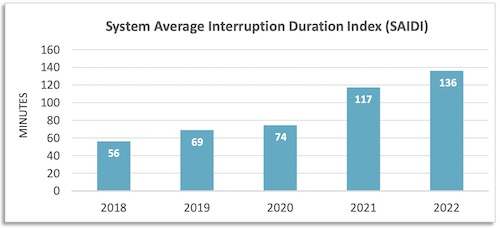
This chart shows the average number of outage-minutes per PG&E customer per year, which has been increasing. Source: CPUC Reliability Workshop, PG&E Presentation (2023)
More locally, let’s take a look at the Peninsula division of PG&E’s grid, which runs down the west side of the Bay from South San Francisco to Santa Cruz. The average outage-minutes per customer was twice as bad in 2021 compared to the five years prior.
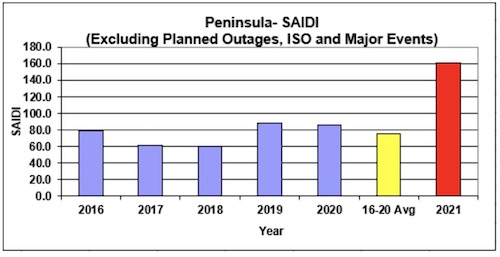
Electric reliability plummeted in 2021 in PG&E’s Peninsula division. Source: PG&E 2021 Annual Electric Reliability Report
PG&E attributes much of the decline in reliability to a program called Enhanced Powerline Safety Settings (EPSS). In high fire-risk areas, PG&E has equipped power lines with an automatic shutoff capability that is enabled during certain weather conditions. When EPSS is enabled, the underlying circuit trips whenever a line is accidentally touched or faults. The circuit stays dead until it is inspected. This has resulted in thousands of multi-hour unplanned outages affecting over 750,000 customers in 2022 alone. (2)
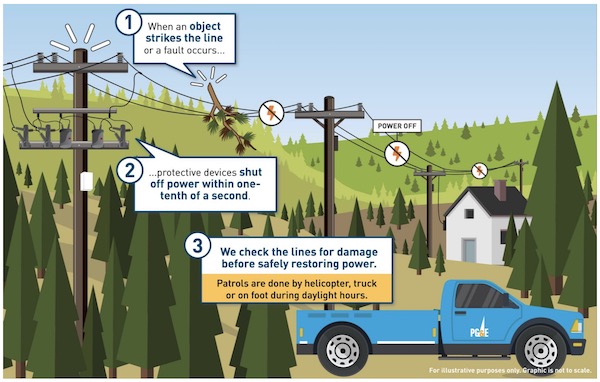
Power lines in high fire-risk areas are enhanced with an automatic shutoff capability called Enhanced Powerline Safety Settings. This wildfire prevention mechanism is causing many outages in rural areas. Source: CPUC Reliability Workshop, PG&E Presentation (2023)
The urban areas where most of us live are not much affected by these “fast trip” outages. EPSS is installed only in high fire-risk or adjacent areas. The unplanned outages that urban residents experience are typically due to equipment failures or some type of animal, vegetation, or third party intrusion. When a Menlo Park reader reports that “This past Sunday evening (which was cool and windless), we lost electrical power for 3 hours in Menlo Park.", it was probably due to one of those events. When your power goes out, you can check PG&E’s outage map (or for Palo Alto, this outage map) for outage information, including the cause.
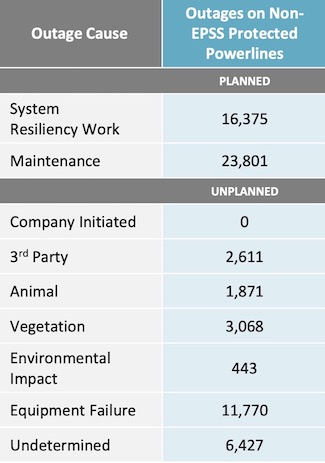
Sources of outages in 2022. SSource: CPUC Reliability Workshop, PG&E Presentation (2023)
PG&E does not share outage data on a city-by-city basis, but the data below for Palo Alto in 2021 indicate reasonable reliability for residents on average. Palo Alto Utilities spokeswoman Catherine Elvert adds that “There are no particularly identifiable areas in Palo Alto that are prone to power outages. Outages can occur for a variety of reasons, including animal or bird coming in conflict with the wires or equipment, downed trees or limbs, high winds, or equipment failure due to factors that affect underground or overhead performance.” I would expect data for most Peninsula cities to be similar, though worse in 2023 due to atmospheric rivers knocking down trees coupled with PG&E’s often slow response times. (3)
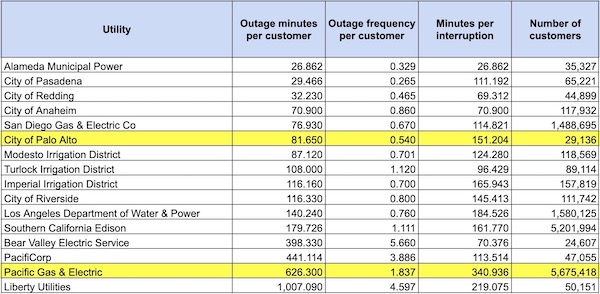
2021 reliability data for a selection of California utilities, with local providers highlighted. Source: U.S. Energy Information Administration
But that is not the whole story. Over half of PG&E territory is in high fire-risk areas, and 100% of power lines there are now EPSS-enabled. The resulting fast-trip outages have significantly impacted reliability in places west of 280 and in the hills of the East Bay, like La Honda, Half Moon Bay, and Mount Diablo.

Over half of PG&E territory is in high fire-risk areas. Source: CPUC Reliability Workshop, PG&E Presentation (2023)
Last year almost 2400 EPSS outages led to over two million (!) customer outages. Medical devices stopped working. Street lights went dark. Schools closed. Hospital procedures were postponed. Credit card readers ceased working. Elevators parked on the first floor. Public meetings were canceled. Food went bad. And this happened over and over in the hardest hit areas.
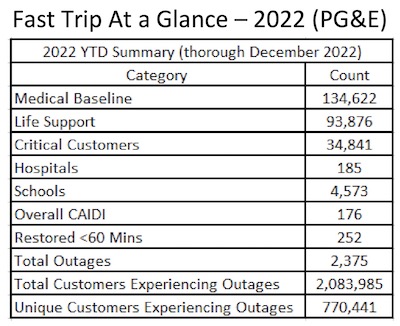
The impact of EPSS-triggered events (aka “fast trip” events) in 2022 was significant. Source: CPUC Reliability Workshop, Joint Parties Presentation (2023)
Disability advocate Connie Arnold weighed in during a March workshop on reliability held by the California Public Utilities Commission (CPUC): “This is a life and death issue for persons with disabilities…. It can mean the inability to even get out of bed (adjustable bed) or to breathe (ventilator).” Megan Somogyi of the Joint Local Government Coalition said the outages have “a massive on-the-ground impact that has imposed significant real-life burdens on customers.” John Kennedy, a Policy Advocate for Rural County Representatives of California, pleaded with the commissioners for relief: “Our communities can’t have another year of Fast Trip outages like we had in 2022.”
The pain is not spread evenly. 15% of the circuits that triggered last year experienced more than eight outages. The situation is so bad in some places that PG&E is touting “improved” data that shows certain circuits can go 1-2 months without an outage. No wonder Lori Parlin, El Dorado County supervisor, reports that residents are complaining that it is “like living in a third-world country.”
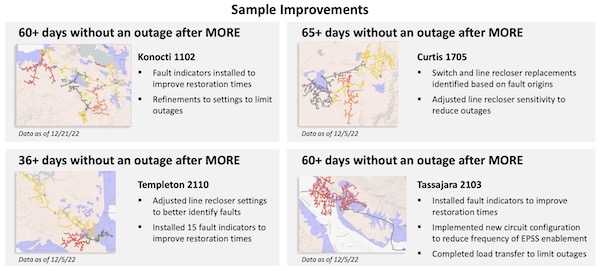
EPSS events have been causing significant outages in places like Clear Lake, Sonora, San Luis Obispo, and Mount Diablo, to the extent that PG&E is boasting when it can keep the power on for just one or two months. Source: CPUC Reliability Workshop, PG&E Presentation (2023)
The Enhanced Powerline Safety Shutoff program is unlikely to go away any time soon because it has been successful in reducing ignitions.
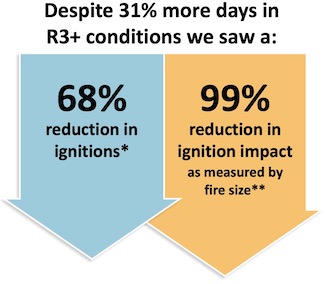
Source: CPUC Reliability Workshop, PG&E Presentation (2023)
But as Justin Hagler, a Senior Regulatory Analyst for California’s Public Advocate’s Office puts it, “The spectrum of conditions under which EPSS is enabled is vast…. Where is the balance point between reliability and safety?” Several speakers at the CPUC workshop emphasized that the steps PG&E is taking to mitigate the harm they are imposing on customers are insufficient. Many disabled people and vulnerable seniors do not know how to get help. Transportation and hotel options may not be readily available to people in wheelchairs. Richard Skaff, Executive Director for Designing Accessible Communities, says he is “appalled”. “They threw these Yeti batteries at us, that might keep a CPAP machine operating for a couple of hours, but not the other kind of major medical equipment or mobility equipment that has a lot greater electricity demand than what a Yeti 3000 can provide. And PGE was so pleased with that. $5M to buy all of those. That’s great. What did PG&E spend on its attorneys last year or the year before? … $250M?”
Rural governments, local power providers, and customer advocates are asking the CPUC to regulate these shutoffs and enforce a balance between fire mitigation and power reliability. PG&E for its part says it is working to reduce the frequency of these shutoffs by hardening lines and narrowing the triggering, and to limit their duration with better fault detection and circuit patrols.
The irony in all of this is that climate change is threatening the reliability of our power system just as we are relying more on electricity to reduce the burning of fossil fuels that is largely responsible for climate change. It’s not just wildfire mitigation that is jeopardizing our electricity supply. Drought is putting our hydropower at risk. High temperatures are worsening transmission losses. Greater demand is stressing our distribution grid. And more intense storms are knocking out power. Said one exasperated San Francisco businessman: “Yesterday the traffic lights were down and my cafe was out of business for three quarters of a day because there was an outage. The wind blows, the rains come, and the power goes off. … We can call them acts of God, but we have known for 30 years that these acts of God were going to increase through human action, and we didn’t prepare, so now we’re stuck… You have some big problems here to solve.”
The climate is changing and the consequences of that are becoming more tangible and more urgent. Corporations like PG&E are responding, but when the response is rushed they are bound to do damage along the way. Regulators like the CPUC have a responsibility to identify and mitigate these harms without unduly impeding progress. It is not easy.
Notes and References
1. This does not include “momentary” outages that last 5 minutes or less.
2. Some of you may be familiar with Public Safety Power Shutoffs (PSPS), which are planned outages announced days in advance of very dry and windy periods. Because of pressure from the CPUC, PSPS events are now less frequent, narrower in scope, and shorter in duration. As shown in the chart below, the Customer Minutes Interrupted (CMI) related to PSPS events (shown in orange) has plummeted in PG&E territory. The outage minutes caused by the newer fast-trip outages (EPSS) are shown in gray. EPSS events are measured in hours rather than the days that were typical of PSPS events, so overall outage duration is less.
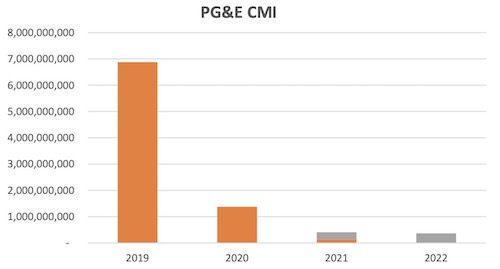
Customer Minutes Interrupted by year for PG&E for PSPS events (orange) and EPSS events (gray). Source: CPUC Reliability Workshop, Public Advocates Office Presentation (2023)
However, the number of people impacted by the EPSS outages has soared to now exceed that of the PSPS events at their worst. The chart below shows the number of outages attributed to each program in each year.
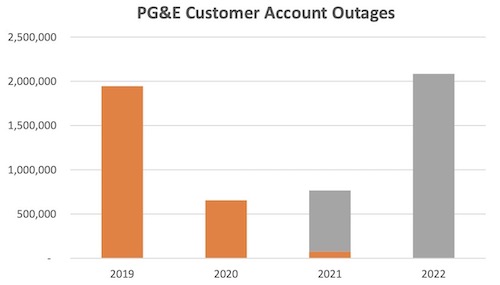
Customer Account Outages by year for PG&E for PSPS events (orange) and EPSS events (gray). Source: CPUC Reliability Workshop, Public Advocates Office Presentation (2023)
The hope is that attention from the CPUC will push utilities to improve the EPSS program in much the same way that they improved the PSPS program.
3. Palo Alto has begun reporting reliability data in the Utilities Quarterly Update. (Yay!) Reliability data for 2021, 2022, and the first two quarters of 2023 are shown below. You can see how the storms in the first quarter of 2023 impacted reliability, and the year is only half over! What is impressive is how quickly Palo Alto resolved the many issues that the storm brought, keeping the minutes per interruption relatively stable. Palo Alto spokeswoman Catherine Elvert says: “Our operations crews were able to restore service to most customers in very quick order. In some cases, power was restored within 15 minutes and in other cases in which power poles were completely broken or lines detached, a matter of hours. I know some PG&E area customers who were without power for several days to more than a week.”

CIty of Palo Alto Utilities electricity reliability data through Q2 2023. Source: City of Palo Alto Utilities Quarterly Update Q2 2023
Current Climate Data (May 2023)
Global impacts, US impacts, CO2 metric, Climate dashboard

Some bike rides are tougher than others… Happy 4th! (Photo taken in South Palo Alto.)
Comment Guidelines
I hope that your contributions will be an important part of this blog. To keep the discussion productive, please adhere to these guidelines or your comment may be edited or removed.
- Avoid disrespectful, disparaging, snide, angry, or ad hominem comments.
- Stay fact-based and refer to reputable sources.
- Stay on topic.
- In general, maintain this as a welcoming space for all readers.




